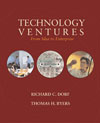 |  Technology Ventures: From Idea to Enterprise Richard C Dorf,
University of California Davis
Thomas H Byers,
Stanford University
Feature SummaryThe book focuses specifically on technology-based ventures, emphasizing the role of the team in technology ventures.
The most noteworthy features of the book are: - Emphasis on the starting and building of high-technology, high-impact ventures. This is the only true textbook to focus on this vital element of our economy.
- Comfortable to students of any major including science, engineering and management.
- Coverage of both startups and entrepreneurial initiatives within existing organizations. This book is an excellent way to teach lifelong leadership skills, no matter what career path is chosen by the student.
- Blend of theory and practice for everything the instructor needs to teach this subject. Numerous case studies and examples from real companies, two full sample business plans, and a "running" case study on a California biotechnology firm are blended into all chapters of the text.
The book is organized in a modular format to allow for both systematic learning and random access of the material to suit the needs of any reader. It is a reference and companion tool to keep on hand for future use. It deploys the following wide variety of methods and features to achieve this goal:Preview
Each chapter opens with a preview that outlines its content and objectives.Principles
A set of twenty fundamental principles are developed and defined throughout the book.Examples
Examples of the concepts are provided in a shaded box format.Sequential Case
A case about an actual biotechnology firm, AgraQuest, runs from one chapter to the next.Exercises
Exercises are offered at the end of each chapter to test comprehension of the concepts.Business Plans and Cases
Two full business plans and seven complete cases are included in the back of the book.References
References are indicated in a box format Smith, 2001 and may be found as a complete set in the back of the book along with valuable sources for additional information.Chapter Sequence
The chapter sequence represents our best effort to organize the material in a format that can be used in various entrepreneurship courses. The chapters follow the four-section layout shown in Figure P1.Website
This website supplements the book with additional information applicable to educators, students and professionals. For example, a complete syllabus for an introductory course on high-technology entrepreneurship is provided. |
|



 2005 McGraw-Hill Higher Education
2005 McGraw-Hill Higher Education

 2005 McGraw-Hill Higher Education
2005 McGraw-Hill Higher Education